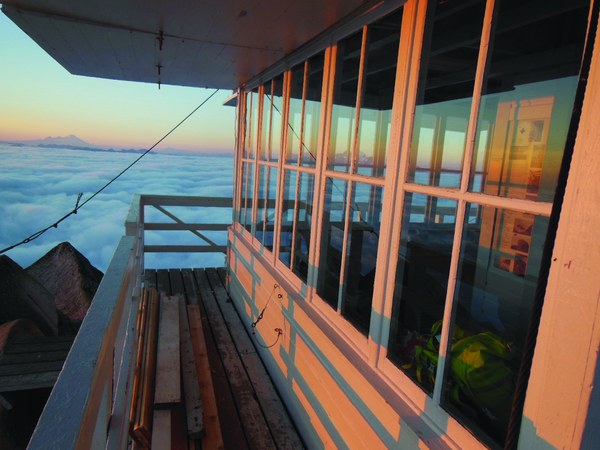
For years, Mountaineers Super Volunteer Richard Babunovic loaded up his Subaru Outback and headed to Mt. Pilchuck - his favorite mountain.
“What’s really great about Mt. Pilchuck are the scrambling opportunities, breathtaking views of Puget Sound, and the diversity of ecosystems. On a single hike, you pass through wet and alpine forests as well as boulder fields,” said Richard.
However, on his last trip he found his well-loved peak nearly inaccessible. The massive potholes on the Forest Service road nearly damaged his car. “The condition of the road was so poor, it looked like continuous waves of dirt,” said Richard. The lack of road maintenance caused Richard to stay away for the last year and a half, impacting both his hiking and his stewardship work helping to maintain the lookout stationed at the top.
Stories like Richard’s are becoming increasingly common. The Forest Service and other agencies have been starved for funding for decades, while outdoor recreation continues to increase. The unfortunate reality is that land managers have been trying to do more with less for a long time.
Funding challenges for National Forests
Since the 1990s, the Forest Service has seen funding and staff reduced across nearly every program. Across the country, we have 50% of the trail crews and forestry technicians we had in 1992, though use has increased by more than 800,000 visits per year. With half the staff and twice the responsibility, National Forests have been struggling, suffering from maintenance issues, increased litter, illegal parking, and more. Forest Service staff are burned out and demoralized.
These issues are largely the result of chronic underinvestment in the Forest Service by Congress. Each year more of its budget goes towards fighting wildfires, leaving little left to respond to, let alone proactively plan for, current challenges. The impacts of Forest Service understaffing also affect capacity to conduct the National Environmental Policy Act analyses and Tribal consultation necessary for recreation and environmental management planning. Climate change, intensifying wildfires, and increasing demand for recreation further underscore the need for bold investment and staff increases.
Impacts on local forests
The impacts of underfunding can be acutely felt in Washington. Since 2000, the population of central Puget Sound has grown by over one million people: the equivalent of adding another Seattle and Tacoma. As evidenced by a 2020 Earth Economics analysis, Washington residents love the outdoors. Outdoor recreation is a $26.5 billion industry in our state, and today many of us routinely experience busy trails, full parking lots, and heavy use of campgrounds and other recreational amenities.
“We have had a hard enough time keeping up with regular maintenance for years given staffing levels,” said Sarah Lange, Recreation Planner for the Mount Baker-Snoqualmie National Forest. “Proactive planning for recreation in the face of climate change will require a lot more capacity and some major capital investments.”
 Mt. Pilchuck fire lookout. Photo courtesy of the Everett Branch.
Mt. Pilchuck fire lookout. Photo courtesy of the Everett Branch.
Recreation projects already take a long time to reach completion. After experiencing severe flood damage in 2006, the process of restoring and improving the Suiattle River Road in the Mount Baker-Snoqualmie National Forest took about 10 years, leaving hikers without access to 120 miles of trails. With less funding for environmental analysis and planning, projects like this will only take longer in the future.
On the Olympic Peninsula, about half of the Olympic National Forest’s employees fulfill the duties of more than one position, limiting their ability to keep up with increased demand, let alone proactively plan for the future.
With new recreationists on the trail across Washington, Forest Service interpretative rangers play a valuable role in ensuring everyone recreates safely and responsibly. Due to this lack of funding, it’s rare to see a ranger out on the trail to answer questions and check permits.
Impacting The Mountaineers
From courses to youth clubs, Mountaineers programs are regularly affected by poor maintenance and closed lands and facilities. Our Everett Alpine Scrambling Course has used the Eightmile Campground in the Okanogan-Wenatchee National Forest for a Rock Skills Course field trip each April since the 1980s. Unfortunately, campgrounds along Icicle Creek were closed to the public during spring last year.
“If underfunding in the local ranger district continues and those campgrounds remain closed in April, it will be difficult to continue offering our course and providing outdoor enthusiasts this opportunity to hone their off-trail mountain travel skills,” said course leader Brian Booth.
The challenges that Mountaineers staff and volunteers often face for securing permits on National Forest lands are directly related to a lack of Forest Service staff capacity. Nationally, 70% of Forest Service staff responsible for administering permits have been assigned to those responsibilities as a secondary duty on top of another job.
Long-term solutions
In spring 2021, The Mountaineers, Winter Wildlands Alliance, and Outdoor Alliance delivered a report to the administration and Congress asking for significant investments in the Forest Service. The Mountaineers and Outdoor Alliance Washington - a network of human-powered outdoor advocacy groups in the state - have also recently stepped up our advocacy for increased Forest Service funding so the agency has the staff capacity they need to meet unique challenges. What we need are long-term increases in annual appropriations funding so that the agency can hire additional permanent staff to tackle long-standing issues.
Along with our report, we provided two key congressional committees with written testimony, asking for a 50% increase in funding for core Forest Service operations like recreation staffing, planning, research, and infrastructure needs. We’re also looking into other solutions, such as allowing one-time funding for capital projects to be used to pay for staffing, and increasing the agency’s ability to partner with nonprofit organizations.
Together with our partners, we’ll continue to build relationships with Forest Service staff across Washington and Oregon to better understand their management challenges, needs, and opportunities. We’re also working to build more champions for Forest Service funding among Washington’s congressional delegation and the diverse group of recreationists in our state, so that we have a better likelihood of seeing increased funding for public lands through the federal appropriations process.
Advocates for forests
With many competing priorities for federal funding, it will likely take years of advocacy, timing, and a little luck to achieve a significant increase in resources for the Forest Service. Each action alert submitted, phone call made, and letter sent to your member of Congress brings us one step closer. The more congressional offices hear from their constituents on an issue, the sooner they’ll be moved to act.
As recreationists and outdoor recreation leaders, your stories - stories like the car-damaging trip to a popular trail head - about how Forest Service funding shortfalls have affected wild places are critical to helping us build and deliver a compelling case for increased funding and staffing for the Forest Service.
Together, we can help achieve a more sustainable future for this critical land management agency, the forests they manage, and the life-changing recreational opportunities they provide.
HOW YOU CAN HELP
- Write to your member of Congress about the importance of increased Forest Service funding.
- Report what you’re seeing in Washington’s forests by emailing conservation@mountaineers.org.
- Receive updates and advocacy opportunities related to Forest Service funding by signing up for Conservation Currents on your Mountaineers profile, or on the footer of our website.
This article originally appeared in our Spring 2022 issue of Mountaineer Magazine. To view the original article in magazine form and read more stories from our publication, visit our magazine archive.
 Conor Marshall
Conor Marshall